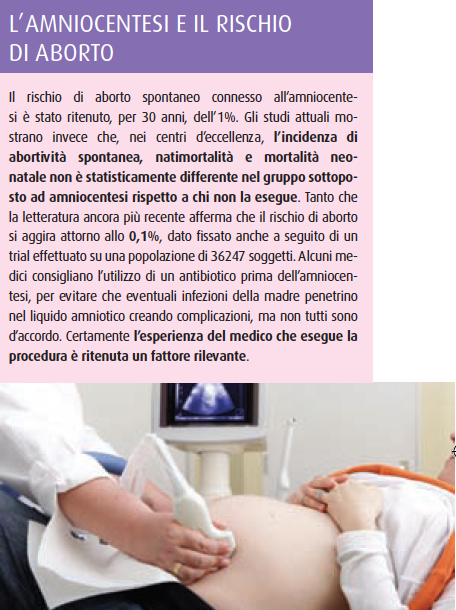It is said and repeated that pregnancy must be lived with serenity. For many mothers-to-be, having the guarantee that your baby will be healthy constitutes truly precious information in this sense, so much so as to influence the choice or not to terminate the pregnancy (and the law allows it, if you are in the presence of a serious anomaly). In Italy, diagnostic tests such as the
tri test or the
integrated test are widespread, but based on statistical results.
Amniocentesis is also increasingly practiced (also due to the raising of the age at which pregnancy is faced - see box on page 40),
which makes it possible to analyze the number and shape of the chromosomes of the fetus and, therefore , to detect any alterations, mainly
trisomy 21 or Down syndrome , as well as less frequent alterations in the number of chromosomes, such as
trisomy 13 and trisomy 18 , and macroscopic mutations in the shape of the chromosomes.
THINGS? 
Not everyone knows it, but amniocentesis is a
very ancient practice , which already has roots in the early 19th century as a surgical practice against polyhydramnios (the overproduction of amniotic fluid, which can lead to complications for the mother) or for the instillation of hypertonic solutions in order to induce abortion. Amniocentesis is
an invasive prenatal diagnosis technique that allows a
withdrawal of amniotic fluid from the uterine cavity by inserting a needle under ultrasound guidance through the maternal abdomen. This liquid contains some fetal cells (amniocytes) in suspension: placed in an appropriate culture medium, they are grown in vitro and then studied in their chromosomal arrangement or in their DNA.
WHEN TO DO IT
The ideal time to perform amniocentesis is between the
16th and 18th week , when the amniotic cavity has reached such dimensions as not to pose a risk to the fetus. However, there is still a
risk of miscarriage associated with amniocentesis (see box above).
Advantages: performed in almost all hospitals, has 100% reliability.
Disadvantages: the need for a short post-examination rest period and abortive labor in case of termination of pregnancy; it does not allow the possibility of a genetic alteration or a malformation of another nature to be excluded.
WHERE TO DO THE AMNIOCENTES I
It is important to verify that the center to which one turns possesses the suitable requisites established by law (Ministerial Decree 22 July 1996; 18 July 1996, n. 382 'Urgent provisions in the health sector' or by the Presidential Decree 14 January 1997). Today it is no longer permitted to carry out invasive prenatal diagnosis procedures in specialist doctor's offices, outpatient clinics or polyclinics that do not meet the requirements for surgical outpatient or day surgery.
Therefore, be careful not to perform the examination in doctors' offices or simple specialist clinics. Such a practice is illegal.
THE ALTERNATIVES
CVS is another prenatal diagnosis that
allows you to analyze some possible chromosomal alterations affecting the fetus. It is also invasive and must be practiced between the
10th and 13th week of gestation , which entails less stress for the woman in the event that abortion is opted for, since a curettage will be carried out and not an abortive delivery . However, it is such an early diagnosis that it is not 100% sure, since some mutations could appear later.

Increasingly popular, then, are
some non-invasive diagnostic tests that are performed starting from a simple blood test. We are talking about the G-Test, from the 10th week of pregnancy, or the Aurora, for which the analyzes are carried out in California, with the risks associated with the travel of the samples. The analyzes are instead made in Italy in the case of the Prenatal-Safe test, which can be performed starting from the 10th week of gestation, and of the Harmony. Currently they are
all paid exams , the results of which are however considered more than reliable.
In general, in Italy the amniocentesis is free if the expectant mother
■ over 35;
■ have children with chromosomal disorders or congenital malformations;
■ underwent nuchal translucency ultrasound combined with serological tests (bi test) or tri test and the result was positive;
■ have had a previous miscarriage;
■ is a healthy carrier, or is her partner, of a genetic disease (thalassaemia or muscular dystrophy);
■ performed artificial insemination;
■ have contracted a Torch group disease (ie toxoplasmosis, rubella, cytomegalovirus).
We point out an interesting related article -->
Can I take care of myself during pregnancy
 Not everyone knows it, but amniocentesis is a very ancient practice , which already has roots in the early 19th century as a surgical practice against polyhydramnios (the overproduction of amniotic fluid, which can lead to complications for the mother) or for the instillation of hypertonic solutions in order to induce abortion. Amniocentesis is an invasive prenatal diagnosis technique that allows a withdrawal of amniotic fluid from the uterine cavity by inserting a needle under ultrasound guidance through the maternal abdomen. This liquid contains some fetal cells (amniocytes) in suspension: placed in an appropriate culture medium, they are grown in vitro and then studied in their chromosomal arrangement or in their DNA.
WHEN TO DO IT
The ideal time to perform amniocentesis is between the 16th and 18th week , when the amniotic cavity has reached such dimensions as not to pose a risk to the fetus. However, there is still a risk of miscarriage associated with amniocentesis (see box above).
Advantages: performed in almost all hospitals, has 100% reliability.
Disadvantages: the need for a short post-examination rest period and abortive labor in case of termination of pregnancy; it does not allow the possibility of a genetic alteration or a malformation of another nature to be excluded.
WHERE TO DO THE AMNIOCENTES I
It is important to verify that the center to which one turns possesses the suitable requisites established by law (Ministerial Decree 22 July 1996; 18 July 1996, n. 382 'Urgent provisions in the health sector' or by the Presidential Decree 14 January 1997). Today it is no longer permitted to carry out invasive prenatal diagnosis procedures in specialist doctor's offices, outpatient clinics or polyclinics that do not meet the requirements for surgical outpatient or day surgery. Therefore, be careful not to perform the examination in doctors' offices or simple specialist clinics. Such a practice is illegal.
THE ALTERNATIVES
CVS is another prenatal diagnosis that allows you to analyze some possible chromosomal alterations affecting the fetus. It is also invasive and must be practiced between the 10th and 13th week of gestation , which entails less stress for the woman in the event that abortion is opted for, since a curettage will be carried out and not an abortive delivery . However, it is such an early diagnosis that it is not 100% sure, since some mutations could appear later.
Not everyone knows it, but amniocentesis is a very ancient practice , which already has roots in the early 19th century as a surgical practice against polyhydramnios (the overproduction of amniotic fluid, which can lead to complications for the mother) or for the instillation of hypertonic solutions in order to induce abortion. Amniocentesis is an invasive prenatal diagnosis technique that allows a withdrawal of amniotic fluid from the uterine cavity by inserting a needle under ultrasound guidance through the maternal abdomen. This liquid contains some fetal cells (amniocytes) in suspension: placed in an appropriate culture medium, they are grown in vitro and then studied in their chromosomal arrangement or in their DNA.
WHEN TO DO IT
The ideal time to perform amniocentesis is between the 16th and 18th week , when the amniotic cavity has reached such dimensions as not to pose a risk to the fetus. However, there is still a risk of miscarriage associated with amniocentesis (see box above).
Advantages: performed in almost all hospitals, has 100% reliability.
Disadvantages: the need for a short post-examination rest period and abortive labor in case of termination of pregnancy; it does not allow the possibility of a genetic alteration or a malformation of another nature to be excluded.
WHERE TO DO THE AMNIOCENTES I
It is important to verify that the center to which one turns possesses the suitable requisites established by law (Ministerial Decree 22 July 1996; 18 July 1996, n. 382 'Urgent provisions in the health sector' or by the Presidential Decree 14 January 1997). Today it is no longer permitted to carry out invasive prenatal diagnosis procedures in specialist doctor's offices, outpatient clinics or polyclinics that do not meet the requirements for surgical outpatient or day surgery. Therefore, be careful not to perform the examination in doctors' offices or simple specialist clinics. Such a practice is illegal.
THE ALTERNATIVES
CVS is another prenatal diagnosis that allows you to analyze some possible chromosomal alterations affecting the fetus. It is also invasive and must be practiced between the 10th and 13th week of gestation , which entails less stress for the woman in the event that abortion is opted for, since a curettage will be carried out and not an abortive delivery . However, it is such an early diagnosis that it is not 100% sure, since some mutations could appear later.
 Increasingly popular, then, are some non-invasive diagnostic tests that are performed starting from a simple blood test. We are talking about the G-Test, from the 10th week of pregnancy, or the Aurora, for which the analyzes are carried out in California, with the risks associated with the travel of the samples. The analyzes are instead made in Italy in the case of the Prenatal-Safe test, which can be performed starting from the 10th week of gestation, and of the Harmony. Currently they are all paid exams , the results of which are however considered more than reliable.
In general, in Italy the amniocentesis is free if the expectant mother
■ over 35;
■ have children with chromosomal disorders or congenital malformations;
■ underwent nuchal translucency ultrasound combined with serological tests (bi test) or tri test and the result was positive;
■ have had a previous miscarriage;
■ is a healthy carrier, or is her partner, of a genetic disease (thalassaemia or muscular dystrophy);
■ performed artificial insemination;
■ have contracted a Torch group disease (ie toxoplasmosis, rubella, cytomegalovirus).
We point out an interesting related article -->Can I take care of myself during pregnancy
Increasingly popular, then, are some non-invasive diagnostic tests that are performed starting from a simple blood test. We are talking about the G-Test, from the 10th week of pregnancy, or the Aurora, for which the analyzes are carried out in California, with the risks associated with the travel of the samples. The analyzes are instead made in Italy in the case of the Prenatal-Safe test, which can be performed starting from the 10th week of gestation, and of the Harmony. Currently they are all paid exams , the results of which are however considered more than reliable.
In general, in Italy the amniocentesis is free if the expectant mother
■ over 35;
■ have children with chromosomal disorders or congenital malformations;
■ underwent nuchal translucency ultrasound combined with serological tests (bi test) or tri test and the result was positive;
■ have had a previous miscarriage;
■ is a healthy carrier, or is her partner, of a genetic disease (thalassaemia or muscular dystrophy);
■ performed artificial insemination;
■ have contracted a Torch group disease (ie toxoplasmosis, rubella, cytomegalovirus).
We point out an interesting related article -->Can I take care of myself during pregnancy



